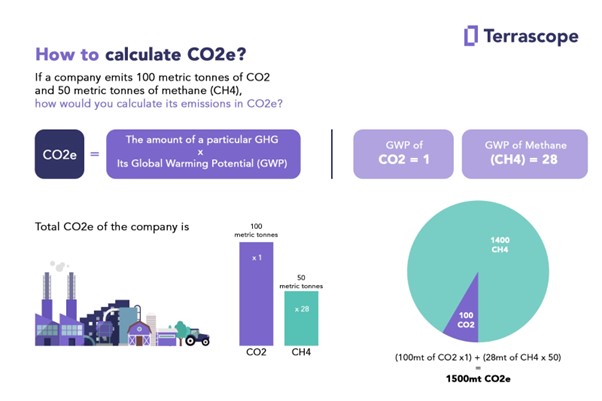Summary
- Greenhouse gases (GHGs) like carbon dioxide, methane, and nitrous oxide are key contributors to climate change, with CO2 accounting for the majority of emissions. Human activities, such as burning fossil fuels and agriculture, significantly increase GHG concentrations.
- CO2e (Carbon Dioxide Equivalent) is a measurement used to compare the impact of different GHGs on climate change by factoring in their global warming potential (GWP).
- CO2e is widely used by companies and governments for sustainability reporting, climate policy, and carbon trading. It affects daily activities like driving, electricity usage, and recycling by calculating the associated emissions.
Introduction
One of the leading causes of climate change is the proliferation of greenhouse gases (GHGs) like carbon dioxide, methane, and nitrous oxide in the atmosphere as a result of human activities. To address this, 196 countries signed the Paris Agreement in 2015, aiming to limit temperature increase to 1.5 °C above pre-industrial levels.
Terrascope’s SaaS-based platform is designed to help enterprises measure their GHG emissions accurately and efficiently, which is a critical step toward setting realistic, science-backed emission reduction goals.
What are greenhouse gases?
Greenhouse gases are a group of gases that are naturally present in the earth's atmosphere or released through human activities.
The Kyoto Protocol, signed in 1997, identified six GHGs as the main contributors to global warming. These gases include CO2, methane, nitrous oxide, hydrofluorocarbons, perfluorocarbons, and sulfur hexafluoride.
Carbon dioxide (CO2) is the most prevalent GHG, accounting for about 76% of global GHG emissions. CO2 is primarily produced by the burning of fossil fuels, such as coal, oil, and gas, which are used for transportation, industry, and homes. Methane, primarily from agriculture, contributes 16% of GHG emissions; and nitrous oxide, mostly from industry and agriculture, contributes 6%.
What is CO2e and how is it different from CO2?
CO2e, or Carbon Dioxide Equivalent, is a unit of measurement used to compare the impact of GHGs on the environment. CO2e provides a unified way to express the contribution of each GHG to climate change. It is based on a GHG’s global warming potential (GWP), which measures how much heat a GHG traps in the atmosphere compared to CO2 over a specific time period — typically 100 years. The GWP of CO2 is set to 1 and the GWPs of other GHGs are expressed relative to CO2.
In other words, CO2e helps enterprises compare the impact of different GHGs. It also allows for the creation of carbon offset programs, which can fund projects that reduce emissions.
For example, methane has a GWP of 28-36, meaning it traps 28-36 times more heat than CO2 over 100 years. Agricultural activities are the predominant source of methane emissions, be it livestock emissions like manure, gastroenteric releases, or cultivating crops such as rice.
Curbing methane emissions is a crucial step for agricultural enterprises on the road to net zero. The US Environmental Protection Agency (EPA) found that methane concentrations in the atmosphere have doubled over the last two centuries, primarily due to human-related activities.
How do I calculate CO2e?
The calculation of CO2e involves multiplying the amount of a GHG emitted by its GWP.

How is CO2e used?
CO2e is a widely used measure that has a direct impact on enterprises. In environmental management, companies use CO2e to track and reduce their GHG emissions and meet sustainability goals. In climate policy, governments use CO2e to establish regulations and policies that aim to reduce emissions and allocate carbon credits in cap-and-trade systems. Meanwhile, in carbon trading, CO2e is used as a currency for companies to buy and sell emissions allowances.
There are also many ways in which we generate CO2e in daily life.
-
Driving a car: The combustion of gasoline in a car engine emits carbon dioxide and other GHGs. The amount of CO2e emitted depends on the type of vehicle and how much it is driven. As a rough estimate, the average passenger car emits around 0.2 to 0.4 kilograms of CO2e per kilometre driven. Assuming an average driving speed of 60 kilometres per hour, driving your car for one hour would result in approximately 12 to 24 kilograms of CO2e emissions.
It's worth noting that this is just an estimate and actual emissions may vary based on other factors such as driving conditions, vehicle age, and maintenance.
-
Using electricity: Generating electricity often involves burning fossil fuels, which emits carbon dioxide and other GHGs. The amount of CO2e emitted per unit of electricity depends on the source of the electricity, such as coal, natural gas, or renewables.
-
Travelling by airplane: Airplanes emit large amounts of carbon dioxide and other GHGs into the atmosphere. The amount of CO2e emitted depends on the distance travelled and the type of aircraft.
-
Heating or cooling a building: Heating or cooling a building often involves using energy from fossil fuels, which emit GHGs. The amount of CO2e emitted depends on the type of fuel used and the efficiency of the heating or cooling system.
-
Recycling: Recycling materials instead of sending them to a landfill can reduce greenhouse gas emissions by reducing the need to produce new materials. The amount of CO2e saved depends on the type and amount of materials recycled and the energy required to recycle them.



